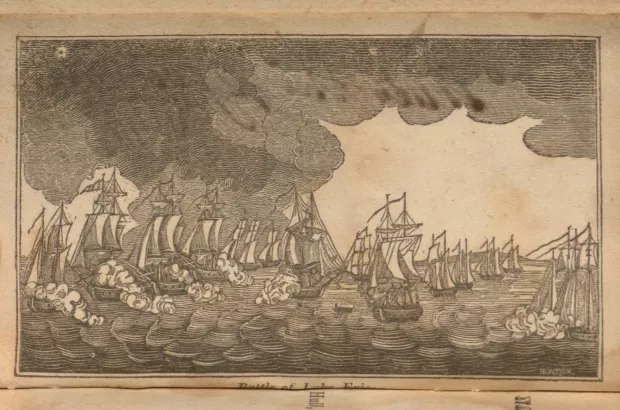Creation Date
1831
Height
6 cm
Width
10 cm
Description
The Battle of Lake Erie, October 10, 1813 was a major event in the War of 1812. With its many American naval victories (like the one depicted here), the war played a significant role in the development of the United States' national identity (R. Stein, Seascape 27). At least fourteen ships are engaged in battle. Dark smoke billows up from the surface of the water on the left horizon line, spreading to either side of the sky and obscuring the entire top of the print. The horizon is low in this image, much like the horizon in Thomas Birch’s Battle of Lake Erie.The ships spew white puffs of cannon smoke toward their opponents; each side is clearly defined. There are no flags to identify the ships’ nationality. There is one row boat near the center that (according to the accompanying text) probably contains Commodore Oliver Perry. This text, “Perry’s Victory,” speaks of Perry leaving the disabled Lawrence and rowing towards the Niagra; coming aboard, he flies his flag and leads the rest of the fleet to victory over the British.
This image makes detailed use of smoke, shadow, and scale to emphasize the courage of the Americans and the justice of their cause. The "thundering artillery" of the song is depicted in the black mass of smoke that rises to tower over the battle, threatening to swallow the entire scene. The shadowed appearance of this smoke, most of which rises from the British fleet, emphasizes the destructive power of the enemy's artillery, and the highlighted smoke spewed by the cannons suggests the remarkable speed of the firing (the “flash” of the “red artillery” described in the song). The fact that the British fleet emits the majority of the smoke enforces the image of Britain as the arrogant aggressor; the American fleet, in contrast, fires much less smoke, and its status as just, wronged defender is enhanced by the American coastline in the background. This impresses upon the viewer the courage of Perry, scarcely visible, standing in the small row boat as he escapes a sinking ship to fight from the quarterdeck of another. The incredibly small size of the boat and the tiny figure of the man are menaced not only by the towering clouds, but by the depths of the lake at the bottom edge of the image; this shadowed deep participates in the same, threatening presence as the blackening smoke. Consequently, these shadows not only serve to give the painting a certain natural balance and to draw the eye to the lighter center of the image, but, more significantly, they draw a parallel between the hostile banks of smoke created by the British fleet and the unknown depths of Lake Erie. This emphasizes the power of Britain, the desperate situation of the American fleet, and the valor of the Perry, who manages to lead his ships to victory while caught between the threat of human destructiveness (the smoke) and the immense, unknown elements (the water). The entire image, then, emphasizes the tremendous effort and courage necessary on the part of the Americans to overcome desperate odds. This corresponds to the theme of the accompanying song: "Perry's Victory" dwells on the unlikelihood of the American victory in order to celebrate the ultimate triumph of the just cause, the defense of "freedom and sailors' rights" eventually overcoming the sordid British lust for "naval glory".
Associated Works
Locations Description
The introduction to The American Naval and Patriotic Songster (1831) was written by "Jolly Tom" in Marine Hospital, a hospital for disabled seamen near Norfolk, VA.
Copyright
Copyright 2009, Department of Special Collections, Memorial Library, University of Wisconsin-Madison, Madison, WI
Publisher
P. N. Wood
Collection
Accession Number
PS595 H5 A4
Additional Information
Bibliography
By courtesy of the Department of Special Collections, Memorial Library, University of Wisconsin-Madison:
Stein, Roger B. Seascape and the American Imagination. New York: Potter, 1975. Print.
The American Naval and Patriotic Songster. Baltimore, 1831. Print.
Tracy, Nicholas. Britannia's Palette: The Arts of Naval Victory. Montreal: McGill-Queen's UP, 2007. Print.

